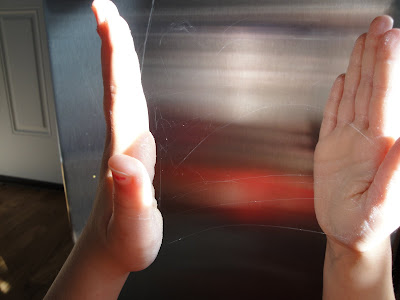
The Teach/Learn Blogging Carnival hosted by Science@home is for anyone, because we are all teachers and learners all the time. This month our theme is “English”, including Speaking, Listening, Reading and Viewing. I think our bloggers have covered all of these and there are lots of resources and game ideas, plus a giveaway. Please read through to the end to find links to the other participating blogs.
I remember working on craft projects in elementary school and rubbing the glue all over my hands, and then letting them dry. Then I would peel the dried glue off of my hand in as big of pieces as possible to see the mold I had made of my fingerprints and the lines of my hands...do you remember doing this too?
Well, we were working on some project that involved glue...and instead of leaving her glue to dry after my daughter rubbed it between her hands, she kept patting her hands together quickly to feel the sticky-stick between them.
Pretty soon, the drying sticky-stick didn't want to let go and strings of drying glue were being spun through the air. She was creating "spider webs" in the air. They looked pretty cool, and she had a great time making them.
 This would be a fun activity to do with your child as you share a few facts with them about spiders and their webs:
This would be a fun activity to do with your child as you share a few facts with them about spiders and their webs:-Types of webs: Tangled, Orb, Sheet, Gum-footed, Horizontal Line, Bolas and Triangle
-Spiders have silk spinning glands called spinnerets, at the tip of their abdomen.
-Web-Spinning spiders only use the tips of their legs when creating their webs so that their body doesn’t come in contact with the web and get stuck. They use a middle claw and the bristles on their leg tips to hang onto a single thread that keeps them balanced until their web is fully made.
-Each spinneret on the spider is different from the other and used for making several kinds of silk: attachment disk silk (leaves a zigzag pattern and gives strength to the dragline), a strong dragline or safety line silk (gives the spider an anchor point), orb web spiral line (gives the web strength and stretchiness to catch flying prey), glue-like sticky catching silk (traps and keeps captured prey on the web), swathing silk (for wrapping and immobilizing prey), tangling cribellate silk (tangles the bristles, spines and claws of prey) and a protective egg sac silk (to keep baby spiders safe).
-Webs get dirty and torn, so lots of spiders make a new one every day. They don't waste the old one, though--they roll it up into a ball and eat it!
These facts taken word for word from:(http://www.pestproducts.com/spider-webs.htm) and (http://www.tooter4kids.com/Spiders/facts.htm)
Check out this link to discover how a wheel web is formed...very cool pictures too:
See ya, Spidey!
CatWay at Adventures With Kids is Magnifying It by playing with magnifying glasses and microscopes to help your child explore the world of the very small.
Deb Chitwood from Living Montessori Now was never very scientifically minded. One year, though, we participated in a homeschool co-op science fair. Two months later we moved and didn’t have the opportunity to participate in a science fair again. But that experience was a great learning opportunity – and, yes, it actually was fun!
Monique from Your Cheeky Monkey is commencing on the road of learning about the Human Body (both inside and out). Find out a few of the things we are doing to learn about our amazing bodies!
SMMART Ideas shows how you can enjoy making these sticky spiderwebs with your child, learn how spiders actually make their webs and other arachna-facts!
Amanda B at HomeAge says that science is not her forte, but for young children the world is one big science lesson. How do we answer all their questions so that these answers are meanings rather than facts?
Narelle from A Bunch of Keys has some simple kid friendly activities to do to help attract birds into the garden.
Deb from Science@home's daughter has decided to be an alienpologist, and she's reflecting on all the different ways kids are exposed to ideas and fun activities.
Staci at Teaching Money to Kids has a simple sorting activity that kids can do anywhere to get them to observe and compare.
Ash from Mm is for Me have been running their own family Science Week with lots of fun activities.
Thanks for visiting our carnival, we hope you find some interesting new blogs.



9 comments:
I didn't know they had different types of spinnerets! I suppose it makes sense though. I loved playing with glue as a kid, I found some gum glue the other day, I think we'll have to make some webs.
I love how simple things can become a learning activity for kids! A great idea for an activity, and thanks for those facts on spiders too!
Very cool!! This would be so much fun!
Great idea! A simple, fun activity that’s an extension to learning new concepts – awesome! Thanks for the interesting facts and links about spiders as well.
Fascinating! And some people might be tempted to think they know a lot about spiders.
I've been amazed recently to see kids being upset at having glue on their hands, because I remember so vividly putting glue on my hands deliberately so that I could peel it off.
I loved playing with glue and peeling it off my hands too, but this was much more interesting. Wonder if Princess would like it now she has deeloped a fear of spiders and webs.
And I didn't know all that about the spinnerets! Very interesting (and nicer then looking at up-close pictures of spider eyes *shudders*).
Last year we did a bug science project. maybe this year we will do spiders.
I had no idea about the spinnerets.
Ooooh! This sounds fun! Will loves playing with glue sticks, so this will be even better - and we can learn some fun spider facts!
This sounds like a fun activity for kids.
Post a Comment